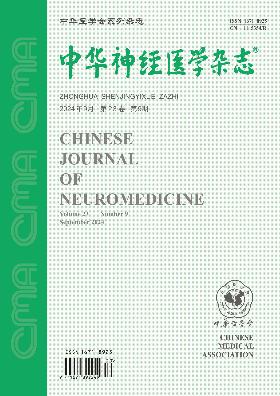Clinical characteristics and risk factors of delayed intracranial hemorrhage after ventriculoperitoneal shunt in traffic hydrocephalus
Q4 Medicine
引用次数: 0
Abstract
Objective To analyze the clinical features and risk factors of delayed intracranial hemorrhage (DICH) after ventriculoperitoneal shunt (VPS) in patients with communicating hydrocephalus. Methods One hundred and seventy-six patients with ventriculoperitoneal shunt due to communicating hydrocephalus secondary to craniocerebral trauma, hypertensive intracerebral hemorrhage, brain tumor or intracranial aneurysm rupture hemorrhage, admitted to our hospital from January 2012 to August 2018, were selected in our study; these patients were divided into DICH group and non-DICH group according to whether or not DICH occurred. The clinical features, including incidence, time and location of DICH, were analyzed. The differences of age, gender, length of stay, concomitant diseases, previous operation history, incidences of subdural effusion and puncture canal edema after ventriculoperitoneal shunt, and history of down-regulating shunt valve within 2 weeks between the two groups were compared by univariate analysis. The independent risk factors for DICH were further assessed using multivariable Logistic regression. Results Among 176 patients, 23 (13.07%) had DICH; 2-11 d after surgery, DICH appeared, manifesting as subdural, ventriculoventricular end canal and/or hemorrhage in one or more areas of the ventricle. There were significant differences in incidence of subdural effusion and history of down-regulating shunt valve within 2 weeks between the two groups (P<0.05). Multivariate Logistic regression analysis showed that subdural effusion after surgery and down-regulation of shunt valve pressure within 2 weeks after ventriculoperitoneal shunt were independent risk factors for DICH (OR=4.516, 95%CI: 1.555-13.110, P=0.006; OR=5.352, 95%CI: 1.987-14.414, P=0.001). Conclusion High incidence of DICH mighty be noted within two weeks of ventriculoperitoneal shunt; subdural effusion and pressure reduction of shunt valve within 2 weeks are independent risk factors for DICH, which needs close monitoring and clinical intervention. Key words: Delayed intracranial hemorrhage; Communicating hydrocephalus; Ventriculoperitoneal shunt; Risk factor交通性脑积水脑室腹腔分流术后迟发性颅内出血的临床特点及危险因素分析
目的分析交通性脑积水脑室腹腔分流术(VPS)后迟发性颅内出血(DICH)的临床特点及危险因素。方法选取2012年1月至2018年8月在我院住院的176例颅脑外伤、高血压脑出血、脑肿瘤或颅内动脉瘤破裂出血继发的交通性脑积水患者;根据是否发生DICH分为DICH组和非DICH组。分析其临床特点,包括DICH的发生率、时间和部位。采用单因素分析比较两组患者年龄、性别、住院时间、合并疾病、既往手术史、脑室-腹膜分流术后硬膜下积液及穿刺管水肿发生率、2周内分流阀下调史的差异。采用多变量Logistic回归进一步评估DICH的独立危险因素。结果176例患者中,DICH 23例(13.07%);术后2-11 d出现DICH,表现为硬脑膜下、脑室端管和/或脑室一个或多个区域出血。两组患者2周内硬膜下积液发生率及下行分流阀史比较,差异均有统计学意义(P<0.05)。多因素Logistic回归分析显示,术后硬膜下积液、脑室-腹膜分流术后2周内分流阀压力下调是DICH的独立危险因素(OR=4.516, 95%CI: 1.555-13.110, P=0.006;Or =5.352, 95%ci: 1.987-14.414, p =0.001)。结论脑室腹腔分流术后2周内DICH发生率较高;硬膜下积液和2周内分流阀压力下降是DICH的独立危险因素,需要密切监测和临床干预。关键词:迟发性颅内出血;脑积水的沟通;Ventriculoperitoneal分流;风险因素
本文章由计算机程序翻译,如有差异,请以英文原文为准。
求助全文
约1分钟内获得全文
求助全文
来源期刊

中华神经医学杂志
Psychology-Neuropsychology and Physiological Psychology
CiteScore
0.30
自引率
0.00%
发文量
6272
期刊介绍:
 求助内容:
求助内容: 应助结果提醒方式:
应助结果提醒方式:


